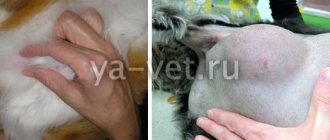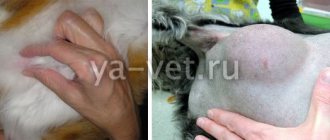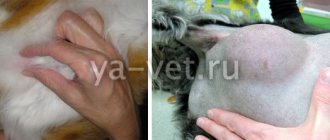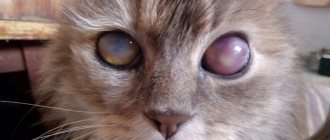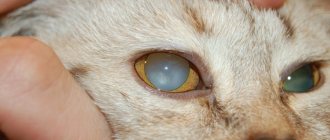In pets, neoplasms are often found located between the skin and the muscle layer. They can be both harmless and dangerous. Therefore, if you find a lump under the skin in a cat, even if it is not inflamed and does not cause discomfort or pain to the pet, make an appointment with a veterinarian to find out the origin of the nodular hardening of the subcutaneous tissue and, if necessary, treat it in time.
Causes and risk factors
Like people, cats age; many processes in the body begin to proceed less quickly and correctly. The likelihood of any disease, including neoplasms, increases as a result of the natural aging process.
The older the cat, the greater the risk of getting sick.
In addition, risk factors include:
- living in an area with unfavorable environmental conditions;
- hereditary predisposition;
- insufficient or poor quality nutrition;
- parasitic infestations;
- mechanical damage;
- insect bites;
- the animal has allergies;
- health problems, certain pathologies;
- immunodeficiency state.
There can be many potential reasons for the development of a pathological process, manifested by the appearance of a subcutaneous lump in an animal. It is very difficult for the owner to determine what exactly is happening to the cat. It is best to show the animal to a specialist.
Treatment of the disease
Based on the diagnostic results, the doctor can make two decisions:
- constant monitoring of the dynamics of the tumor;
- performing surgery to remove a lipoma.
Surgery to remove a simple lipoma is usually simple and is done under local anesthesia. A large tumor that is difficult to reach may require general anesthesia.
Preparation for the operation should include the following:
- it is necessary to inform the surgeon about what medications the animal has taken recently;
- you should not feed the cat on the last day before surgery;
- You need to give her enough fluids.
In the case of a burst wen, the operation to remove it is transferred from the category of planned to the category of urgent.
This operation usually does not last long, after which the patient recovers quite quickly. The doctor makes an incision and removes the capsule containing the wen, separating it from healthy tissue. The resulting cavity is carefully stitched. Healing usually goes well, and after 7-10 days the stitches are removed.
If the surgeon has to deal with an infiltrating lipoma that has grown into muscle tissue, then it takes more time to free the affected muscles. This increases the wound surface, and, accordingly, rehabilitation lasts longer. Sometimes large nerves in the back are involved in the pathological process. In this case, special professionalism is required from the doctor so as not to damage them without impairing the sensitivity and motor function of the body.
The postoperative period requires maintenance therapy:
- prescribing sedatives, antibiotics and anti-inflammatory drugs;
- prescribing IVs with an electrolytic solution to combat dehydration;
- home monitoring of the animal's condition;
- A protective collar on the cat's neck will help protect the post-operative area from licking and infection.
Deterioration in the animal’s well-being requires urgent consultation with a veterinarian.
Associated symptoms
Apart from the presence of a lump under the skin, the animal may not show any other symptoms. Wen and benign neoplasms, as a rule, do not manifest themselves in any way.
In some cases, the tumor constantly increases in size, as a result a large lump grows and begins to interfere with the cat and cause inconvenience. In such cases, measures should be taken as soon as possible.
Firstly, the rapid growth of a tumor is a dangerous sign. And secondly, the cat will try to get rid of the irritating factor by scratching or trying to rip off the bump in some way. This can lead to aggravation of the pathological process, injury, and bleeding from the damaged area.
In some cases, when a cat develops a gradually enlarging lump under the skin, a number of additional symptoms are observed. Suppuration or an inflammatory process may be accompanied by hyperemia of the affected area, skin tension, swelling and severe pain. Also, due to the activity of pathogenic microflora, symptoms of intoxication increase: fever, weakness, and sometimes nausea and vomiting.
Allergic reactions can be accompanied by extremely unpleasant itching sensations for the cat. Itchy skin provokes scratching, damage to the skin and aggravation of the problem.
Diagnostics
The origin of some subcutaneous lumps in a cat can be determined by their appearance. For example, a sucking tick can be easily detected by the owner of the animal upon careful examination. An experienced veterinarian can usually accurately diagnose a lipoma, abscess or hematoma.
To determine the diagnosis, first of all, an anamnesis is collected: the age of the cat is specified, the presence of any pathologies and diseases, how long ago the lump appeared under the skin, whether it is growing and whether it is bothering the animal. Then the doctor palpates the area of neoplasia and the surrounding tissue to find out the size of the lump, its mobility, and the condition of nearby lymph nodes.
It is important to know! Most benign tumors have clear boundaries, low density and a smooth surface. Malignant neoplasms are characterized by blurred outlines and a lumpy surface; rapid growth is also typical for them.
In many cases, additional examinations are required to make an accurate diagnosis: These may be histological or cytological tests to determine the structural structure of the tumor, as well as analysis of the contents of neoplasia to identify bacteria, fungi or invasions. A biopsy provides the opportunity to clearly differentiate benign from malignant formations. This is the name of the procedure for taking a small amount of tissue from the thickness of the neoplasm for cytological analysis.
Possible reasons for the appearance
Let's look at the most common causes of bumps appearing under the skin of a cat.
Lipoma is a benign neoplasm formed by adipose tissue cells and is also called a wen. It can grow quickly or remain the same size and does not metastasize. Lipoma can be localized on any part of the cat’s body: on the back, stomach, withers, neck, chin and other places.
Disturbances in the functioning of the endocrine system, hormonal imbalances, and lack of exercise can provoke the appearance of lipomas. As a rule, it does not cause discomfort to the animal. This is a round, mobile formation in the shape of a ball that rolls freely under the skin. It is painless, but if it is large in size, located near nerve endings or in the spine area, then when pressing on it the animal may feel pain.
It is necessary to understand that any benign neoplasm can take on a malignant nature, especially with constant or single, but strong mechanical impact (if a cat rubs or scratches the wen, in case of an accidental blow).
An abscess is an encysted purulent formation. The cause may be an unsuccessful injection, notoedrosis, insect bite, wound, scratch.
The development of an abscess after an injection (administration of a drug or vaccine) can occur due to infection in the wound, hypothermia, or for other reasons. After vaccination or other injections, a compaction, the so-called infiltrate, may form on the cat’s body. But if infection does not get into the wound, then this formation will resolve on its own after a fairly short time.
Sometimes a foreign body can get under the skin of a cat, and then, without causing suppuration, “take root” there. Such bumps do not grow and do not cause any discomfort to the animal, except with excessive pressure.
If a cat walks outside, it can pick up a tick. In this case, a swollen seal also appears on the body. The tick must be carefully removed, slowly unscrewing it. You cannot tear it off, as the remaining parts of the tick’s body will provoke an inflammatory process.
In addition, ticks are carriers of dangerous infectious diseases, so it is advisable to submit the remains of the insect for analysis to a laboratory.
The appearance of swollen lumps under the lower jaw, usually symmetrical, indicates the development of lymphadenitis. This condition may indicate a viral or bacterial infection, for example, panleukopenia, tularemia, bartonellosis and others, as well as fungal infections. Inflamed lymph nodes are painful, the animal is depressed and does not feel well.
Treatment is necessary, after which the lymph nodes return to normal size. Vaccination saves you from most viral infections that are deadly for cats.
The appearance of lumps may be associated with diseases such as mastitis or mastopathy. The inflammatory process affects the mammary gland, causing very painful sensations. Sometimes the formation reaches a significant size and is localized on the chest, in the nipple area.
Most often, the development of these diseases is associated with stagnation of milk (for example, a cat has lost kittens).
Sometimes mastopathy can also affect young cats that have never experienced pregnancy. This happens due to hormonal therapy. In such cases, cats feel very bad; touching the inflamed area is impossible and causes acute pain.
Another reason for the appearance of a lump on an animal’s body is a cyst. This is a cavity formation filled with serous fluid. Cysts are localized on any part of the body, including the head. Most often, the cause of their appearance is blockage of the sebaceous glands or impaired lymph circulation in a certain area. They are usually painless and do not cause any discomfort to the animal.
The cyst can be quite small, and sometimes such neoplasms reach significant sizes. It can persist for a long time, but it happens that the capsule breaks and serous contents flow out of it.
Sometimes cysts are formed by parasites. Most often, helminths such as alveococcus and echinococcus are prone to their formation (both external and internal). A breakout of a parasitic cyst is also dangerous for the cat’s owner, since these parasites are common to cats and humans.
As a result of a bruise, a cat may experience subcutaneous hemorrhage, leading to the formation of a hematoma. This causes pain to the animal, often at the site of the hematoma the local temperature is increased, the skin is tense, and swelling of the soft tissues is observed. Color can vary from purple to red. In some cases, the area of the hematoma may become infected and begin to fester. Sometimes a dense infiltrate remains at the site of internal hemorrhage.
The most dangerous reason for the appearance of a lump is oncology.
Cancer is the scourge of our time; it spares neither people nor animals. If a cat develops a malignant tumor, the animal becomes lethargic, loses appetite and interest in games and its usual activities, and begins to quickly lose weight. The appearance of such symptoms is a reason to immediately contact a veterinarian. Cancerous tumors can be of any size and usually tend to get larger. Today, oncology in cats can be treated; it is necessary to treat the animal.
Abscess on the neck
A lump on your cat's neck may be an abscess. This is a cavity filled with pus. It appears at the sites of wounds and injuries, and may be a consequence of skin irritation by parasites, in response to which the pet scratched the wound.
Abscess symptoms:
- Homogeneous structure of the neoplasm.
- Redness and increased temperature of the skin around the affected area.
- Pain when pressing.
With an abscess, the cat is constantly trying to reach the tumor. If she can't scratch her neck with her paw, she starts rubbing herself against the furniture. Thus, the animal tries to get rid of the annoying lump on its own.
Since an abscess is a purulent inflammation, a general deterioration in the pet’s well-being is possible. The cat may become lethargic or, on the contrary, irritated and refuse to be handled.
Only a veterinarian can quickly relieve an animal of discomfort. The abscess is opened with a scalpel, then the cavity filled with pus is cleaned out and the wound is treated with antiseptic. If necessary, the doctor may apply stitches and prescribe antibiotics to prevent the inflammation from reoccurring.
We recommend the article: When to castrate a cat: optimal age, advantages and disadvantages.
An abscess can open on its own, but this is dangerous for the animal’s health. The cat can lick off the purulent contents, but there remains a risk of re-infection of the resulting wound.
Signs
Under the skin, between the skin and the muscle layer, nodules or capsules with liquid contents may form in your pet. They are “dough-like”, mobile and do not cause trouble for your pet. The lumps may be hard and painful.
Subcutaneous formations consist of degenerated tissues, or are capsules filled with contents (dense or serous). They have normal body temperature or are dense and hot to the touch. At the same time, the animal’s general body temperature may increase, and other signs of general intoxication may appear (weakness, refusal to eat, irritability or lethargy, dyspepsia). Formations prone to rapid growth deserve special attention.
